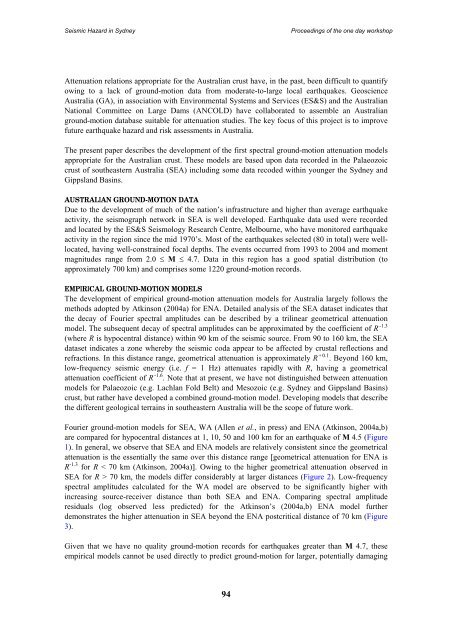Landslides in the Sydney Basin - Geoscience Australia
Landslides in the Sydney Basin - Geoscience Australia
Landslides in the Sydney Basin - Geoscience Australia
- No tags were found...
Create successful ePaper yourself
Turn your PDF publications into a flip-book with our unique Google optimized e-Paper software.
Seismic Hazard <strong>in</strong> <strong>Sydney</strong>Proceed<strong>in</strong>gs of <strong>the</strong> one day workshopAttenuation relations appropriate for <strong>the</strong> <strong>Australia</strong>n crust have, <strong>in</strong> <strong>the</strong> past, been difficult to quantifyow<strong>in</strong>g to a lack of ground-motion data from moderate-to-large local earthquakes. <strong>Geoscience</strong><strong>Australia</strong> (GA), <strong>in</strong> association with Environmental Systems and Services (ES&S) and <strong>the</strong> <strong>Australia</strong>nNational Committee on Large Dams (ANCOLD) have collaborated to assemble an <strong>Australia</strong>nground-motion database suitable for attenuation studies. The key focus of this project is to improvefuture earthquake hazard and risk assessments <strong>in</strong> <strong>Australia</strong>.The present paper describes <strong>the</strong> development of <strong>the</strong> first spectral ground-motion attenuation modelsappropriate for <strong>the</strong> <strong>Australia</strong>n crust. These models are based upon data recorded <strong>in</strong> <strong>the</strong> Palaeozoiccrust of sou<strong>the</strong>astern <strong>Australia</strong> (SEA) <strong>in</strong>clud<strong>in</strong>g some data recoded with<strong>in</strong> younger <strong>the</strong> <strong>Sydney</strong> andGippsland Bas<strong>in</strong>s.AUSTRALIAN GROUND-MOTION DATADue to <strong>the</strong> development of much of <strong>the</strong> nation’s <strong>in</strong>frastructure and higher than average earthquakeactivity, <strong>the</strong> seismograph network <strong>in</strong> SEA is well developed. Earthquake data used were recordedand located by <strong>the</strong> ES&S Seismology Research Centre, Melbourne, who have monitored earthquakeactivity <strong>in</strong> <strong>the</strong> region s<strong>in</strong>ce <strong>the</strong> mid 1970’s. Most of <strong>the</strong> earthquakes selected (80 <strong>in</strong> total) were welllocated,hav<strong>in</strong>g well-constra<strong>in</strong>ed focal depths. The events occurred from 1993 to 2004 and momentmagnitudes range from 2.0 M 4.7. Data <strong>in</strong> this region has a good spatial distribution (toapproximately 700 km) and comprises some 1220 ground-motion records.EMPIRICAL GROUND-MOTION MODELSThe development of empirical ground-motion attenuation models for <strong>Australia</strong> largely follows <strong>the</strong>methods adopted by Atk<strong>in</strong>son (2004a) for ENA. Detailed analysis of <strong>the</strong> SEA dataset <strong>in</strong>dicates that<strong>the</strong> decay of Fourier spectral amplitudes can be described by a tril<strong>in</strong>ear geometrical attenuationmodel. The subsequent decay of spectral amplitudes can be approximated by <strong>the</strong> coefficient of R -1.3(where R is hypocentral distance) with<strong>in</strong> 90 km of <strong>the</strong> seismic source. From 90 to 160 km, <strong>the</strong> SEAdataset <strong>in</strong>dicates a zone whereby <strong>the</strong> seismic coda appear to be affected by crustal reflections andrefractions. In this distance range, geometrical attenuation is approximately R +0.1 . Beyond 160 km,low-frequency seismic energy (i.e. f = 1 Hz) attenuates rapidly with R, hav<strong>in</strong>g a geometricalattenuation coefficient of R -1.6 . Note that at present, we have not dist<strong>in</strong>guished between attenuationmodels for Palaeozoic (e.g. Lachlan Fold Belt) and Mesozoic (e.g. <strong>Sydney</strong> and Gippsland Bas<strong>in</strong>s)crust, but ra<strong>the</strong>r have developed a comb<strong>in</strong>ed ground-motion model. Develop<strong>in</strong>g models that describe<strong>the</strong> different geological terra<strong>in</strong>s <strong>in</strong> sou<strong>the</strong>astern <strong>Australia</strong> will be <strong>the</strong> scope of future work.Fourier ground-motion models for SEA, WA (Allen et al., <strong>in</strong> press) and ENA (Atk<strong>in</strong>son, 2004a,b)are compared for hypocentral distances at 1, 10, 50 and 100 km for an earthquake of M 4.5 (Figure1). In general, we observe that SEA and ENA models are relatively consistent s<strong>in</strong>ce <strong>the</strong> geometricalattenuation is <strong>the</strong> essentially <strong>the</strong> same over this distance range [geometrical attenuation for ENA isR -1.3 for R < 70 km (Atk<strong>in</strong>son, 2004a)]. Ow<strong>in</strong>g to <strong>the</strong> higher geometrical attenuation observed <strong>in</strong>SEA for R > 70 km, <strong>the</strong> models differ considerably at larger distances (Figure 2). Low-frequencyspectral amplitudes calculated for <strong>the</strong> WA model are observed to be significantly higher with<strong>in</strong>creas<strong>in</strong>g source-receiver distance than both SEA and ENA. Compar<strong>in</strong>g spectral amplituderesiduals (log observed less predicted) for <strong>the</strong> Atk<strong>in</strong>son’s (2004a,b) ENA model fur<strong>the</strong>rdemonstrates <strong>the</strong> higher attenuation <strong>in</strong> SEA beyond <strong>the</strong> ENA postcritical distance of 70 km (Figure3).Given that we have no quality ground-motion records for earthquakes greater than M 4.7, <strong>the</strong>seempirical models cannot be used directly to predict ground-motion for larger, potentially damag<strong>in</strong>g94
















